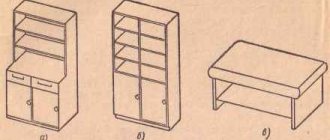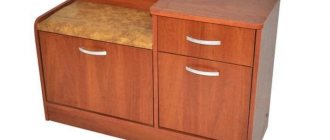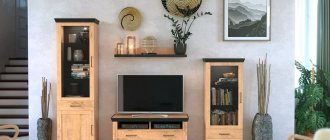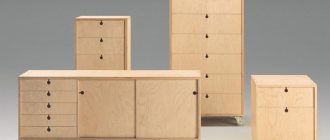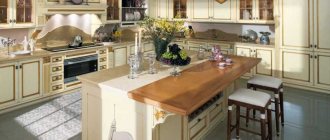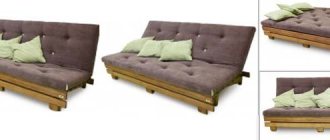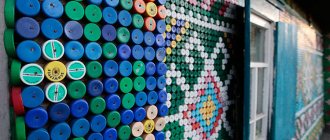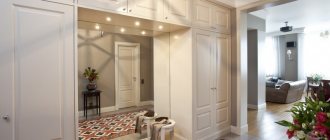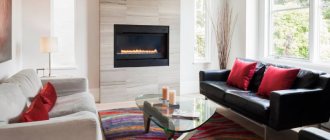Content
- 1 Concept of fittings
- 2 Furniture fittings - the intricacies of furniture production
- 3 Furniture fittings are coming
- 4 Types of fittings 4.1 Fastening fittings
- 4.2 Furniture hinge
- 4.3 Furniture guides
- 4.4 Furniture fasteners
- 4.5 Shelf supports
The first furniture fittings were ropes and nails, with the help of which people fastened furniture parts together. And if the form and functional purpose of furniture on a historical scale have not undergone significant changes, then the production of accessories has made an unimaginably big leap. What does this capacious concept include: “accessories for furniture making.” Furniture production does not stand alone; the word “furniture” is found quite often, and in different areas of industry and production. The most widely used concepts are “furniture fittings” and “window fittings”. So what is fittings? ACCESSORIES
- the totality of all metal and plastic parts in the design of a furniture product, without which its existence is impossible. Furniture components are made of metal and plastic; facial accessories can also be made of wood, glass, and ceramics. Furniture fittings are several tens of thousands of items used in the manufacture of furniture.
With the help of fittings, a movable and fixed connection of furniture parts is ensured, as well as the interaction of furniture with a person and his home. In the industry standard “Furniture accessories. General technical requirements” provides a classification of furniture fittings products, which includes more than 110 types. It should be said that in the manufacture of furniture, various glass products, plastic and metal containers, dish dryers, mirrors and other products related to furniture components are also used. Properly chosen fittings have a positive effect on the architectural and artistic design of furniture, the organization of the technological process for manufacturing furniture, the strength and durability of m
food, ease of use
Oddly enough, furniture accessories play no less a role than other furniture components: cabinet walls, their doors or shelves. Moreover, the cost of these components (of course, if they are of high quality) makes up a very impressive part of the cost of the furniture produced. This is especially true for kitchens, wardrobes, but, above all, dressing rooms. Even in an ordinary closet you will find many, sometimes inconspicuous, but very useful helpers - elements of furniture fittings. Very high demands are placed on retractable mechanisms, which are usually equipped with shelves and drawers of cabinets, chests of drawers, bedside tables, computer and desks, etc. Easy, almost silent and sliding drawer extension makes the use of cabinet furniture as comfortable as possible. Sliding wardrobes also owe their popularity to the ease of opening the door: without making any effort, even a child can take clothes out of the closet and just as easily push the door back.
Fittings for cabinet furniture have not undergone significant changes for quite a long time and are not particularly diverse. Only with the development of production technologies, with the advent of fierce competition in the market, did experts think about the need for more evolutionary and original solutions in the field of furniture fittings. Now the variety of connecting units and components allows you to turn the most daring design solutions into reality. Thus, the presentation of the product is improved, and its competitiveness increases. Today, trivial corner ties and roller guides are being replaced by increasingly modernized and varied auxiliary products for the production of cabinet furniture. In general, one of the distinctive features in the development of the furniture industry over the last decade is the intensive growth in the production of fittings in terms of their range and range. The quality characteristics of fittings are improved. Increasing their reliability, durability, and cleanliness of workmanship also leads to an increase in the quality of the furniture products themselves. The functional type (range) of fittings products is also expanding. This allows you to create furniture samples with new or improved consumer properties. The model (assortment) variety of fittings is increasing. There is an opportunity for greater variation in the design and composition of furniture, for a more accurate match of the external characteristics of fittings and furniture in their color, texture, shape, and in general - in style. It is not uncommon for some furniture products to consist almost entirely of fittings selected from a catalog, for example, work chairs and wardrobes. In specialized catalogs today, for example, the supports of stools, chairs, armchairs and tables, the “back-seat” block, load-bearing elements of the shelving structure, plinths, cornices, mesh shelves, metal sliding doors, bed frames, frames for upholstery products appear in this capacity. furniture, kitchen worktop covers.
All these elements can be divided: - fastening fittings, - functional (front) fittings.
This division of accessories is quite arbitrary, because some fasteners can perform the “duties” of the front one. A special place in this series is furniture edging and edging materials in general (edging tapes, edging glue, etc.). We also note a variety of mortise profiles and furniture edgings. By the way, profiles for finishing furniture edges can also be applied.
Accessories
Sliding wardrobes have become popular due to their spaciousness, functionality and the ability to be installed even in the smallest rooms.
The design of a standard compartment-type wardrobe makes it easy to increase the number of shelves, change the design by replacing the doors with similar ones. Furniture screed is a special type of fastener that is used exclusively in furniture production. Such fasteners can not only significantly facilitate the process of assembling furniture, but also become “invisible” after installation. IN .
The main task of the guides is to ensure silent and smooth operation of drawers. In addition, such systems provide reliability and ease of use, which plays an important role for housewives. In the past, retractable.
Today, most consumers do not know how drawers move, how the fronts open and on what. But in fact, this is very interesting and that’s what we’re talking about.
Furniture fittings mean various auxiliary elements used for the production of this or that furniture. One of the leading manufacturers of such items is the Hettik company. Fittings from Hettich are in high demand in.
More than 5,700 specialists at the Austrian furniture fittings manufacturer Blum focus on perfect movement. That is why the company produces products whose advantages are impeccable work, unique design, and high quality.
Modern manufacturers of furniture fittings offer a wide range of products of this type. However, among the many different companies specializing in the manufacture of furniture accessories, the products of the BOYARD company are in particular demand among consumers. IN .
Boyard Blum TBM Hettich Braun Raumplus HAFELEE FENNEL INOXA industrie Volpato Cebi Starax Furniture fittings are an integral part of the design of any room and allow you to create a cozy and harmonious environment in it. .
Glass fittings perform several important functions at once. Firstly, this is protection. The use of metal fasteners, stands and holders allows you to protect the integrity of the glass surface, protect it from chips, cracks and vibration. Secondly, .
Over time, every piece of furniture, whether upholstered or otherwise, tends to break, get dirty, or simply require minor repairs. To correct all damage and replace dirty covers or upholstery.
Glass doors and facades must be installed using special fittings. Glass hinges are different from regular types. Familiarization with the differences and principles of installation will help you choose the right and high-quality installation of glass furniture elements. .
Not a single piece of furniture is made without the use of fittings. The strength and durability of the structure and ease of use depend on it. It is also worth noting that each type of furniture has its own.
Piano hinges (also called card hinges) are a single-hinged multi-tubular mechanism consisting of two plates: one of which is attached to the inside of the facade (both with and without grooves).
The quality and reliability of furniture fittings is a guarantee of long service life of any piece of furniture. Not the last element in furniture fittings is the furniture hinge - a semi-mechanical device that serves to fasten the facade to the furniture body and.
In this article we will discuss the advantages and disadvantages of various sliding systems used as sliding wardrobe doors. Recently, there have been a lot of proposals for inexpensive systems, mostly manufactured.
When purchasing furniture fittings for a wardrobe , always pay attention to its quality. The ease of use and quality of the cabinet as a whole will directly depend on the fittings. Throughout its entire service life, it...
What kind of kitchen furniture you use will determine, first of all, its quality, as well as how convenient it will be to use. These, at first glance, .
Furniture hinge
A device by which the door is attached to the frame of a furniture product. Hinges are the most important element that ensures the functioning and reliability of a furniture door. The most common are brass or brass-plated hinges (zinc or steel alloys). It is brass-plated on top so that the hinge does not rust and its parts slide better. Sometimes furniture hinges are coated with enamel of different colors or other compounds that imitate bronze, gold, or chrome. Modern four-hinged hinges, even those produced by the same company, differ in design, variety of purposes and external design. Based on the type of fastening, hinges can be divided into overhead, inset, semi-overlay, and complex hinges. Overhead hinges are furniture hinges in which the part to be opened completely covers the end of the supporting part and is located at an angle of 90° to it. Inset hinges are furniture hinges in which the outer plane of the part to be opened is at an angle of 90° to the supporting part and in the same plane as its end.
Semi-overlay hinges - this type of furniture hinge is used when two opposite hinges are installed on one load-bearing part, while the parts to be opened cover the end of the load-bearing part (each by an equal half depending on the model of the hinge used) and are also at an angle of 90 ° to her.
Complex hinges are furniture hinges in which the angle of rotation when opening can be +-45°, +-30°, 180° and differs from the standard opening angle of 95-110°.
Types of kitchen fittings
The satisfaction of being in the kitchen depends not only on the beauty of the wall, wallpaper or ceiling, but also on ergonomics. Constantly opening the doors of the spice cabinet, choosing a knife in the drawer are such familiar things that you practically don’t pay attention to them. But any malfunction in the retractable mechanism, jamming or breakage immediately catches the eye and spoils the mood.
To avoid this, before purchasing you should select the best options for kitchen fittings, which include: • handles and legs for furniture; • hanging rail systems; • hinges for drawers and doors; • boxes with a retractable mechanism.
About the features and characteristics of door handles
On the Russian market you can find 4 types of kitchen handles: • staples; • roof rails; • buttons; • mortise.
From Koba
Koby is the most popular option for door fittings because it doesn’t look flashy and fits into any setting. Such models are most often made of metal and vary in shape: they can be geometrically smooth, curved, textured.
Furniture guides
Guides are a drawer pull-out system. All extension systems can be divided into two types: - guides for ordinary drawers made of chipboard or wood; - boxes that have metal parts in their design (sides, sometimes back walls)
Roller and ball guides
.
Roller
— easy to use and, when installed correctly, make it easy to open and close drawers.
Ball guides
- high-tech, diverse, differing in complexity.
They allow the drawers to be fully extended, provide smooth operation and silent, soft closing of the drawers. Metaboxes
are sidewalls for economy class boxes. Metaboxes are made on the basis of roller guides, but have serious differences. The metabox set consists of two support guides (left and right) and two guides, which are also the side walls of the box (left and right). This is one of the conveniences of metaboxes, because... there is no need to make the side walls of the box from chipboard or other material. You only need to make the bottom, back wall and front of the box of the required size. And the fact that the bottom is made of laminated chipboard (mostly the thickness of laminated chipboard is 16mm), and not from fiberboard (mostly the thickness of fibreboard is 4mm), gives the product extraordinary strength and reliability. Another advantage of metaboxes is the fastenings for the facade, which are adjustable, ensuring that the front of the box is installed exactly on the body of the furniture. There are also special extension bars for metaboxes that allow you to increase the working height of the metabox to the desired size, and separation systems will allow you to properly organize the workspace inside the metabox itself. Metaboxes are made of steel, 1.2mm thick and coated with high-strength enamel in various colors (mainly white and metallic). The material of the rollers themselves is high-strength plastic, designed for more than one thousand openings. The load (weight of the box) supported by metaboxes directly depends on their length. The longer the length, the less the load: from 10kg to 20kg. (open state). Metaboxes are considered a partial extension system (3/4), i.e. extend three-quarters of their total length. Metaboxes can be used for both overlay and inset facades.
Alpha Box
- high-tech drawer pull-out mechanism. The Alpha drawer is equipped with a maintenance-free guide system that is hidden from view under other parts and is highly resistant to lateral loads. The high-quality drawer pull system has excellent movement and easily pulls drawers into the cabinet. The guide system requires no maintenance and is highly wear-resistant. It leaves no traces of metal abrasion or any other contaminants: cleanliness and hygiene are guaranteed! Maximum load - 40kg. White boxes are entered into the warehouse program.
Fastening accessories for furniture
These structures are used to connect parts. This group includes the following types of products.
Furniture hinges
Used when installing sashes and doors. They are made of metal and must have a large margin of strength, withstand constant loads, holding the door or flap and ensuring its opening and closing. Loops can have different designs. The angle of opening of the sash, the specific method of fastening, the possibility of independently returning the sash to the closed position, and the possibility of fixing the door in the open position at a certain angle depend on it.
Lifting mechanisms and elevators
They are an alternative to hinges; they are most often used if it is necessary for the sash to open in a vertical plane (recline). Elevators and lifting mechanisms can have different designs, be mechanical and gas. A damping function can also be provided, in which the open sash can be fixed in any position.
Shelf holders
Used for fastening shelves inside custom-made cabinet furniture. They may involve a fixed fastening, as well as fixing with the possibility of folding the shelf.
Ties
This group includes fasteners whose sole purpose is to secure individual parts relative to each other. Bolts, screws, self-tapping screws, angles, etc. can be used as ties.
Accessories for drawers
These are systems of guides and rollers that ensure the movement of boxes in a horizontal plane. As a rule, such systems have travel limiters.
Sealing elements
They are made from different materials, from PVC to silicone. They have two main functions: ensuring tight, reliable joining of parts and protecting their joints from mechanical destruction.
Particularly stringent requirements are imposed on the quality of fastening hardware. It must be reliable and durable, ensuring trouble-free operation of the furniture for many years. Another important nuance is compactness. Such products should not be too large; it is important that they are inconspicuous and do not take up too much space - this will save interior furniture space.
For custom kitchens we use only high-quality, durable and reliable fittings. It is selected taking into account a number of parameters - from the weight and size of individual parts to appearance and functionality. The right choice of such products is the key to ensuring that the furniture will last a long time and its use will be truly comfortable.
Furniture fasteners
The fasteners that ensure the fixed interaction of furniture elements include: - ties, - screws, - confirmations, - dowels, - self-tapping screws, - corners, etc. Moreover, all these listed fasteners belong to the group of screeds, but they are called differently. If we take the origins of furniture, then at the beginning of carpentry there was no such variety of fasteners as now, and all furniture was built on locking joints, tenons, “dowels” (now dowels
and wedges, which gave strength to benches and tables. Since then, a lot of things changed, but the dowel remained the fastener still used today. Dowels (8X30), however, also acquired different sizes, received corrugation and a precise chamfer at the ends. Everything else gave way to special fittings. Connecting furniture on dowels now gives us the opportunity to quickly and correctly position furniture parts during assembly, and prevents their mutual displacement during operation, absorbing all lateral loads. A dowel is a very cheap and simple part, but it also has its own difficulties. It is made from natural wood and when made from unseasoned wood or when If stored improperly, it can change its cylindrical shape, which significantly affects the quality of the connection.However, small-sized furniture is connected using dowels alone.
With large product sizes and correspondingly increasing loads, the dowels can no longer withstand pulling out, that is, longitudinal forces, and therefore, ties can always be found next to them. A screw tie or barrel tie
consists of only two elements: a screw and a “barrel” - a cylindrical part with a transverse threaded hole.
The “barrel” itself is made entirely of metal or plastic with a nut inserted inside (however, its diameter increases somewhat). The tie is very strong, since when tightening the screw, very large forces are generated and a long tightening stroke is generated, but visible screw heads always appear on the side surface of the product, spoiling its appearance. Of course, the head of the screw, especially with a hex slot, can be covered with a plastic plug, but the appearance will still leave much to be desired. The screed is not very easy to assemble. The hole in the barrel must line up exactly with the screw. Therefore, the mutually perpendicular axes of the holes for the “barrel” and for the screw in the layer and end of the part must intersect exactly. When the installed “barrel” is simply turned the wrong way, it is easy to turn it around using a specially provided slot at the end. But if the hole under it is too deep, and he simply “drowned” in it, it is extremely difficult to pull him back out. Conical coupler. The desire to hide the screw head from the front surface led to the modernization of the “barrel” coupler. As a result, the screw that passes through the attached part of the assembled furniture frame has been replaced by a rod that is screwed into a body with a threaded hole, screwed or pressed flush into the part. Two holes are drilled in the main part: one at the end, for the rod, the other, perpendicular to the first, in the plane, for the “barrel”. The rod, at the end of which a conical recess is formed on the side surface, passes through the transverse hole of the body, along the axis of which there is a threaded hole with a screw. The tip of the screw has a pointed conical shape and when the screw is screwed in, it rests on the side surface of the recess of the tie rod, displacing it together with the attached part to the end of the main one, which is what achieves tension in the connection. Screed furniture corner. The product is also very simple in design: a strip of metal bent at a right angle with a hole on one arm and a groove on the other. It consists entirely of five elements: an angle, two countersunk screws and two threaded fittings. During assembly, the angle is attached with screws to the parts being connected using metal or plastic fittings with an internal threaded hole. The tightening force is achieved by displacing the axis of the fastening hole on one of the parts being connected. As a result, when screwing the screw, it presses with the cone of its head on the conical side surface of the hole in the corner, displacing the entire attached part and attracting it. At one time, this screed even became predominantly widespread in our industry, because: it is durable; does not require drilling holes in the ends; easy to install; unpretentious to the accuracy of the location of filler holes; Disadvantages: visible; interferes with the use of furniture; there are a lot of defects in its production; As for attempts to use metal or plastic corners secured with screws to connect furniture parts, it is better not to buy furniture with such joints: this is not a screed at all, and it is impossible to obtain a reliable tense corner joint in any furniture with their help. The screw tie, or euroscrew, or euroscrew, or confirmat
screw, is usually made of carbon steel. In Europe this tie is called "Einteilferbinder" or "single element tie". And for some reason we call it a “euroscrew” or “euroscrew”. Although the name “screw tie” is much more suitable for it, especially since it is like two drops of water like a screw, only thick and blunt. Depending on the manufacturer, as well as the specifics of production, confirmations have different coatings: electro-galvanized, brass-plated, nickel, about 5 mm thick. The simplest screed, which has found such wide use among our furniture makers precisely because it does not require practically any precision at all when adding. Only two holes are drilled: one at the end of the main part, the other in the plane attached to it. The most popular are Euroscrews with a thread diameter of 7mm and a length of 50 or 70mm. Screeds from different manufacturers have their own design features. The small diameter of the head often allows, using force, to embed the screed flush with the surface of the slab without first countersinking the hole. Also, screw ties may have a specially provided “tooth” under the head, similar to a flash in a poorly made nail, which ensures that it is screwed in flush without countersinking, forming a chamfer for the hole.
A high-quality screed should not have a displacement of the head or slot relative to the axis. If this alignment does not exist, then the tie will go unevenly when screwed in, and the thread will break the hole, which impairs the strength of the connection between the chipboard parts. A tie with a smaller pitch of turns and a larger thread point provides a more durable connection. The first four turns of the thread are conical and have special serrations. Therefore, the tie works like a tap or self-tapping screw, ensuring the cutting of smooth, high-quality threads to accommodate the remaining turns without disturbing the structure of the slab. Disadvantages: head visible from the end. It is usually closed with a plug; furniture assembled on such a screed cannot be assembled more than three times, since the threads cut in such a soft material as chipboard are likely to break. The trouble is that many manufacturers, rightly hoping for the strength of the metal, have completely stopped using dowels together with this screed. But if the assembly is carried out without securing the parts in the loan, then the parts may “lead away,” which can be noticeable when inspecting some products. Eccentric coupler
– a type of connecting fittings that combines low visibility and high strength of the connection and provides the possibility of repeated assembly of the product.
Ties from different manufacturers have their own characteristics, and because of their characteristics, eccentric couplers are also called minifixes, rondofixes and raffixes - these words are derived from the names of eccentric couplers from different manufacturers. The principle of operation of the tie: A metal or plastic sleeve is screwed or pressed into the face of the attached part, flush with it, into which the tie rod with a “T”-shaped head is screwed. When assembling the product, the rod passes through a hole in the end of the main part, and its head ends up in the middle of a transverse hole drilled in its face. An eccentric is installed in it, gripping the rod head with its internal eccentric surface. With further rotation, the eccentric, turning in its hole and acting on the head of the rod, first brings the parts to be connected together, and then creates the necessary force in the connection. An eccentric coupler consists of a cast metal eccentric, a fitting and a rod. There are also quite a lot of designs of such couplers, in which the rod is wrapped directly into the material of the attached part, without the use of a sleeve. The main difference between eccentric couplers is the diameter of the eccentric. The larger it is, the greater the stroke of the tie and the greater the possible force. Eccentrics with a diameter of 25, 15 and 12 mm are used. Eccentrics with a diameter of 25 mm, and sometimes 15 mm, must be closed with a plastic plug. Disadvantages: possible weakening of the tie during use of the product. Different manufacturers solve this problem in different ways. For some couplers, the internal working surface of the eccentric is made concave, and the spherical working surface of the rod head is in contact with it. In other designs, the internal working surface of the eccentric is stepped, and the adjacent working surface of the rod head is flat. In this case, the outer surface of the eccentric is equipped with oblique smoothed teeth, inclined in the direction opposite to the direction of its rotation during assembly, which, while increasing adhesion to the material of the part, additionally prevents its spontaneous rotation and weakening of the connection during operation of the product. Also, the notches inside the eccentric increase its grip on the rod three times compared to a smooth flat surface. An eccentric coupler requires extremely precise relative positioning of all mating holes. Drilling these holes “on the knee” often leads to breakage of the eccentric when applying force during assembly. Actually, the lack of precise filler equipment limits the widespread use of eccentric couplers in domestic furniture. Screw (derived from the German Schraube) is a screw driven into wood or other soft material, in which the screw itself forms a thread by deforming the material. The screw can be screwed into any material due to the threads that are made on the screw shaft. The thread of a screw is different from the thread of screws and bolts screwed into metal. It is taller and has a larger cutting pitch. The threaded portion of the screw has a conical shape, tapering towards the end of the screw. The thread can be cut either along the entire length or only on part of the screw. The sizes of screws also vary depending on the tasks that are solved with their help. Self
-tapping screws are fasteners in shape that correspond to the definition of a SCREW, but with significant design improvements (primarily the shape of the thread, tip and slot), made of high-quality materials with various corrosion-resistant and aesthetic coatings. These improvements make it possible to frequently use screws without pre-drilling holes (which significantly simplifies and speeds up the installation process of fastened products), as well as to use screws for fastenings on a metal (aluminum, steel, etc.) base and in building materials (concrete, brick, etc.). P.). Such screws have significantly expanded the scope of their application and have significantly influenced the technology of many construction and mechanical assembly works. Since the new screws were radically different from the traditional ones, a new term appeared in everyday life - SCREWS. This concept more accurately shows the purpose and capabilities of new screws, although today it is not legalized by the corresponding standard.

